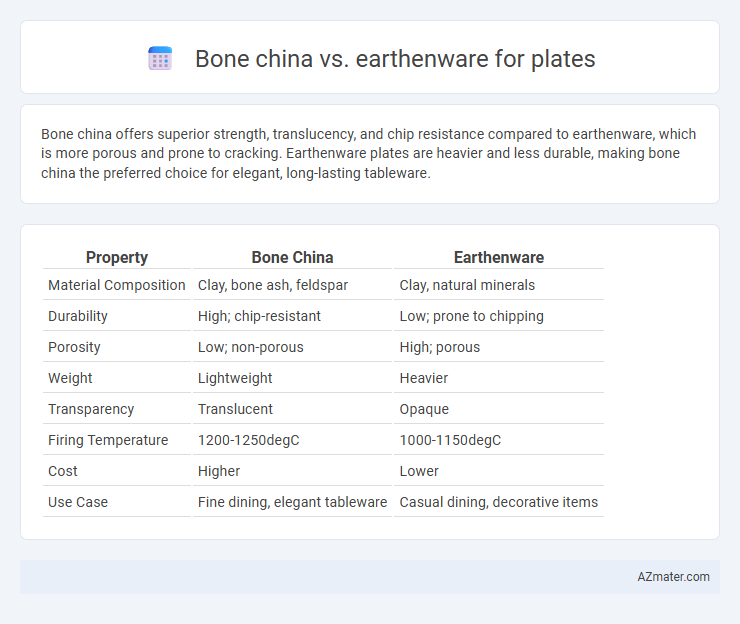Bone china offers superior strength, translucency, and chip resistance compared to earthenware, which is more porous and prone to cracking. Earthenware plates are heavier and less durable, making bone china the preferred choice for elegant, long-lasting tableware.
Table of Comparison
| Property | Bone China | Earthenware |
|---|---|---|
| Material Composition | Clay, bone ash, feldspar | Clay, natural minerals |
| Durability | High; chip-resistant | Low; prone to chipping |
| Porosity | Low; non-porous | High; porous |
| Weight | Lightweight | Heavier |
| Transparency | Translucent | Opaque |
| Firing Temperature | 1200-1250degC | 1000-1150degC |
| Cost | Higher | Lower |
| Use Case | Fine dining, elegant tableware | Casual dining, decorative items |
Introduction to Bone China and Earthenware
Bone china is a highly durable and translucent type of porcelain made from a mixture of bone ash, feldspar, and kaolin, prized for its strength and elegant appearance. Earthenware, by contrast, is a porous, opaque ceramic fired at lower temperatures, composed mainly of clay and known for its rustic and heavier feel. Both materials offer distinct aesthetic and functional qualities ideal for plates, with bone china favored for fine dining and earthenware for casual, everyday use.
Material Composition and Manufacturing Process
Bone china is composed primarily of bone ash, kaolin, and feldspar, resulting in a translucent, durable, and white finish, produced through high-temperature firing and multiple glazing stages. Earthenware, made from natural clay mixed with water and fired at lower temperatures, is porous, less durable, and opaque, often requiring a glaze to make it suitable for tableware. The manufacturing process of bone china emphasizes refinement and strength, while earthenware retains a more rustic texture due to its simpler, lower-temperature firing technique.
Durability and Strength Comparison
Bone china plates exhibit superior durability and strength due to their high calcium phosphate content, making them more resistant to chipping and cracking compared to earthenware. Earthenware plates are more porous and less vitrified, resulting in weaker structural integrity and increased susceptibility to breakage under impact. The vitrification process in bone china also contributes to its enhanced mechanical properties, providing longevity and resilience in everyday use.
Appearance: Color, Texture, and Finish
Bone china plates exhibit a translucent, milky white color with a smooth, glossy finish that imparts an elegant and delicate appearance. Earthenware plates typically have a more opaque, earthy tone, ranging from beige to reddish-brown, with a matte or semi-glossy surface texture that feels rustic and sturdy. The fine, refined texture of bone china contrasts sharply with the thicker, coarser consistency of earthenware, highlighting differences in craftsmanship and aesthetic appeal.
Weight and Thickness Differences
Bone china plates are significantly lighter and thinner compared to earthenware plates due to their high bone ash content, which enhances strength while reducing weight. Earthenware plates tend to be heavier and thicker, composed of porous clay fired at lower temperatures, resulting in a denser and more robust feel. This difference in material composition affects not only the weight and thickness but also the overall durability and elegance of the plate.
Everyday Use: Practicality and Maintenance
Bone china plates offer superior durability and chip resistance, making them ideal for everyday use while maintaining an elegant appearance. Earthenware plates are more porous and prone to chipping, requiring gentle handling and less frequent dishwasher use to preserve their finish. The ease of maintenance and long-term durability of bone china make it a practical choice for daily dining settings.
Price and Affordability
Bone china plates generally command higher prices due to their refined composition and durability, making them a premium choice for tableware. In contrast, earthenware plates are more affordable, appealing to budget-conscious consumers seeking functional and rustic options. The cost difference stems from manufacturing processes and material quality, with bone china offering longevity that may offset its initial expense over time.
Health and Safety Considerations
Bone china plates contain higher levels of calcium phosphate from animal bones, making them less porous and more resistant to bacteria growth, thereby enhancing food safety. Earthenware plates are more porous and prone to chipping, which can harbor bacteria and lead to potential contamination if not properly glazed and maintained. Both materials should be lead-free and tested for heavy metals like cadmium to ensure they meet health and safety standards for food use.
Environmental Impact and Sustainability
Bone china plates, made from a mixture of bone ash, feldspathic material, and kaolin, offer durability and a longer lifecycle, reducing the frequency of replacement and minimizing waste. Earthenware plates, fired at lower temperatures, tend to be more porous and less durable, leading to higher breakage rates and increased environmental impact due to more frequent disposal. The production of bone china involves higher energy consumption but benefits from recycling potential and less resource depletion compared to earthenware, which relies heavily on natural clay sources with limited sustainability.
Choosing the Best Plate: Bone China vs Earthenware
Bone china offers superior durability, translucency, and a fine, smooth finish, making it ideal for elegant dining and long-term use. Earthenware is heavier, more porous, and less chip-resistant, but provides a rustic charm and is often more affordable and microwave-safe. Choosing the best plate depends on whether you prioritize sophistication and durability (bone china) or affordability and casual style (earthenware).

Infographic: Bone china vs Earthenware for Plate
 azmater.com
azmater.com